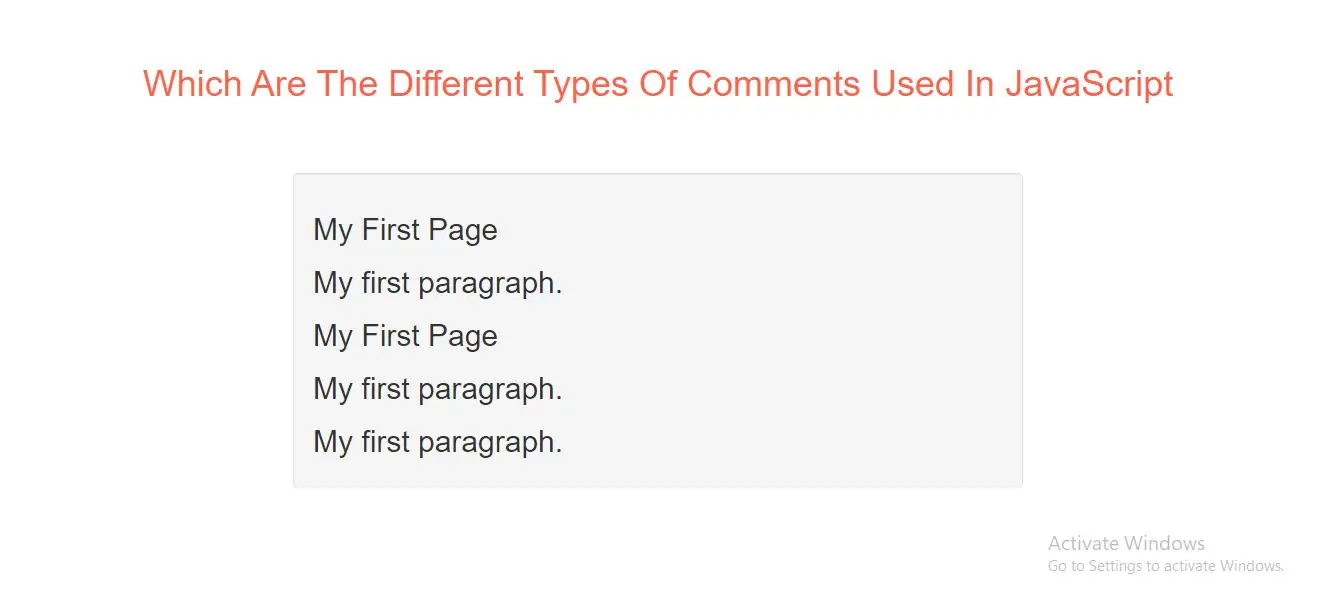
Single Line Comments
Single line comments start with //.
Any text between // and the end of the line will be ignored by JavaScript (will not be executed).
This example uses a single-line comment before each code line:
Example(1)
// Change heading:
document.getElementById("myH").innerHTML = "My First Page";
// Change paragraph:
document.getElementById("myP").innerHTML = "My first paragraph.";
var x = 5; // Declare x, give it the value of 5 var y = x + 2; // Declare y, give it the value of x + 2
Multi-line Comments
Multi-line comments start with /* and end with */.
Any text between /* and */ will be ignored by JavaScript.
This example uses a multi-line comment (a comment block) to explain the code:
Example(3)
/*
The code below will change
the heading with id = "myH"
and the paragraph with id = "myP"
in my web page:
*/
document.getElementById("myH").innerHTML = "My First Page";
document.getElementById("myP").innerHTML = "My first paragraph.";
Using Comments to Prevent Execution
Using comments to prevent execution of code is suitable for code testing.
Adding // in front of a code line changes the code lines from an executable line to a comment.
This example uses // to prevent execution of one of the code lines:
Example(4)
//document.getElementById("myH").innerHTML = "My First Page";
document.getElementById("myP").innerHTML = "My first paragraph.";
This example uses a comment block to prevent execution of multiple lines:
/*
document.getElementById("myH").innerHTML = "My First Page";
document.getElementById("myP").innerHTML = "My first paragraph.";
*/
Complete Code For Different Types Of Comments Used In JavaScript.
<!DOCTYPE html>
<html>
<head>
<title>Which Are The Different Types Of Comments Used In JavaScript</title>
<meta charset="utf-8">
<meta name="viewport" content="width=device-width, initial-scale=1">
<link rel="stylesheet" href="https://maxcdn.bootstrapcdn.com/bootstrap/3.4.1/css/bootstrap.min.css">
</head>
<body>
<div class="container">
<br>
<br>
<br>
<div class="text-center">
<h1 id="color" style="color: tomato">Which Are The Different Types Of Comments Used In JavaScript</h1>
</div>
<br>
<br>
<br>
<div class="col-md-2"></div>
<div class="col-md-8">
<div class="well">
<h2 id="demo1"></h2>
<h2 id="demo2"></h2>
<h2 id="demo3"></h2>
<h2 id="demo4"></h2>
<h2 id="demo5"></h2>
</div>
</div>
<div class="col-md-2"></div>
<script>
// Change heading:
document.getElementById("demo1").innerHTML = "My First Page";
// Change paragraph:
document.getElementById("demo2").innerHTML = "My first paragraph.";
var x = 5; // Declare x, give it the value of 5
var y = x + 2; // Declare y, give it the value of x + 2
/*
The code below will change
the heading with id = "myH"
and the paragraph with id = "myP"
in my web page:
*/
document.getElementById("demo3").innerHTML = "My First Page";
document.getElementById("demo4").innerHTML = "My first paragraph.";
//document.getElementById("myH").innerHTML = "My First Page";
document.getElementById("demo5").innerHTML = "My first paragraph.";
/*
document.getElementById("myH").innerHTML = "My First Page";
document.getElementById("myP").innerHTML = "My first paragraph.";
*/
</script>
</div>
</body>
</html>